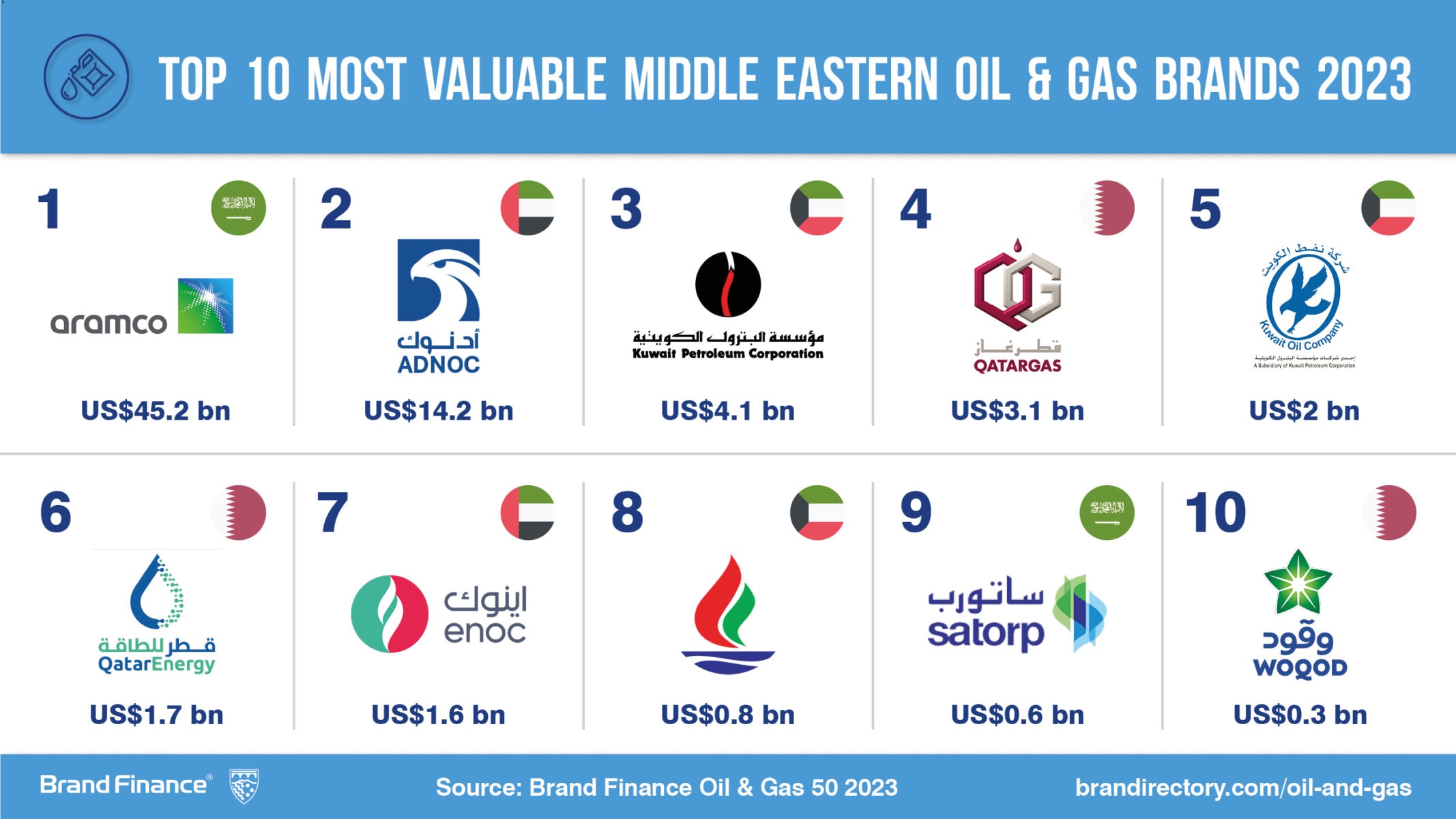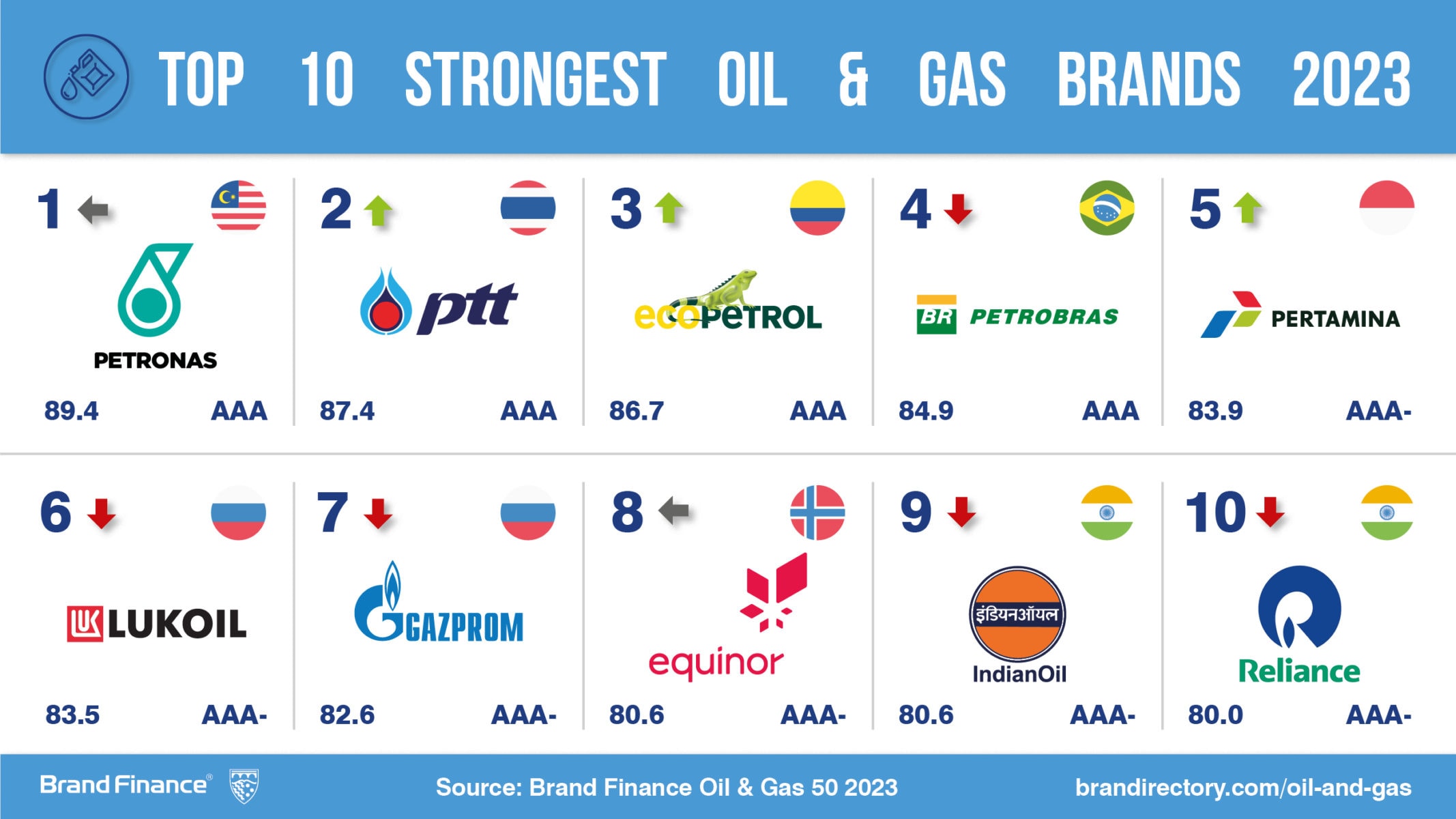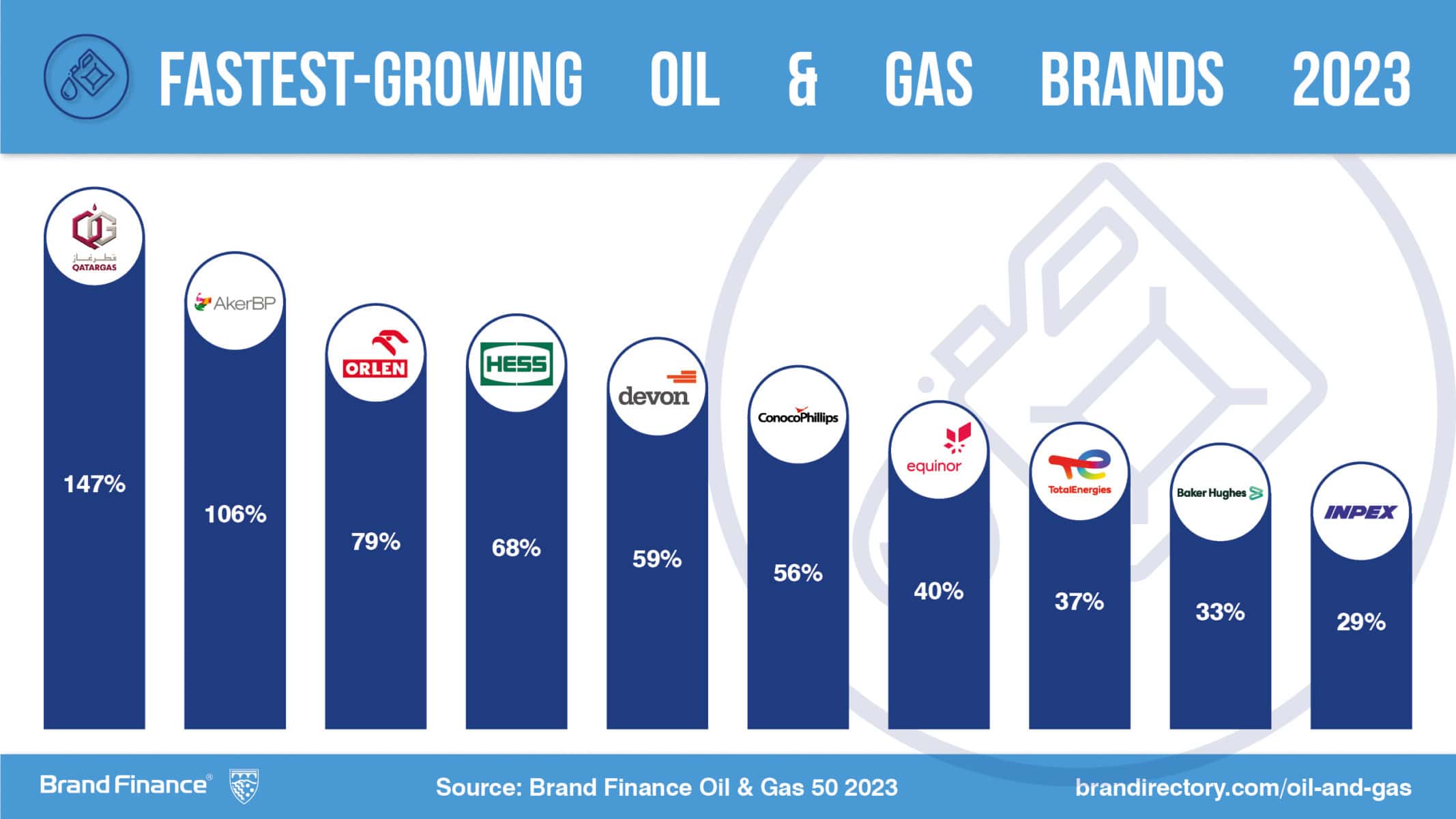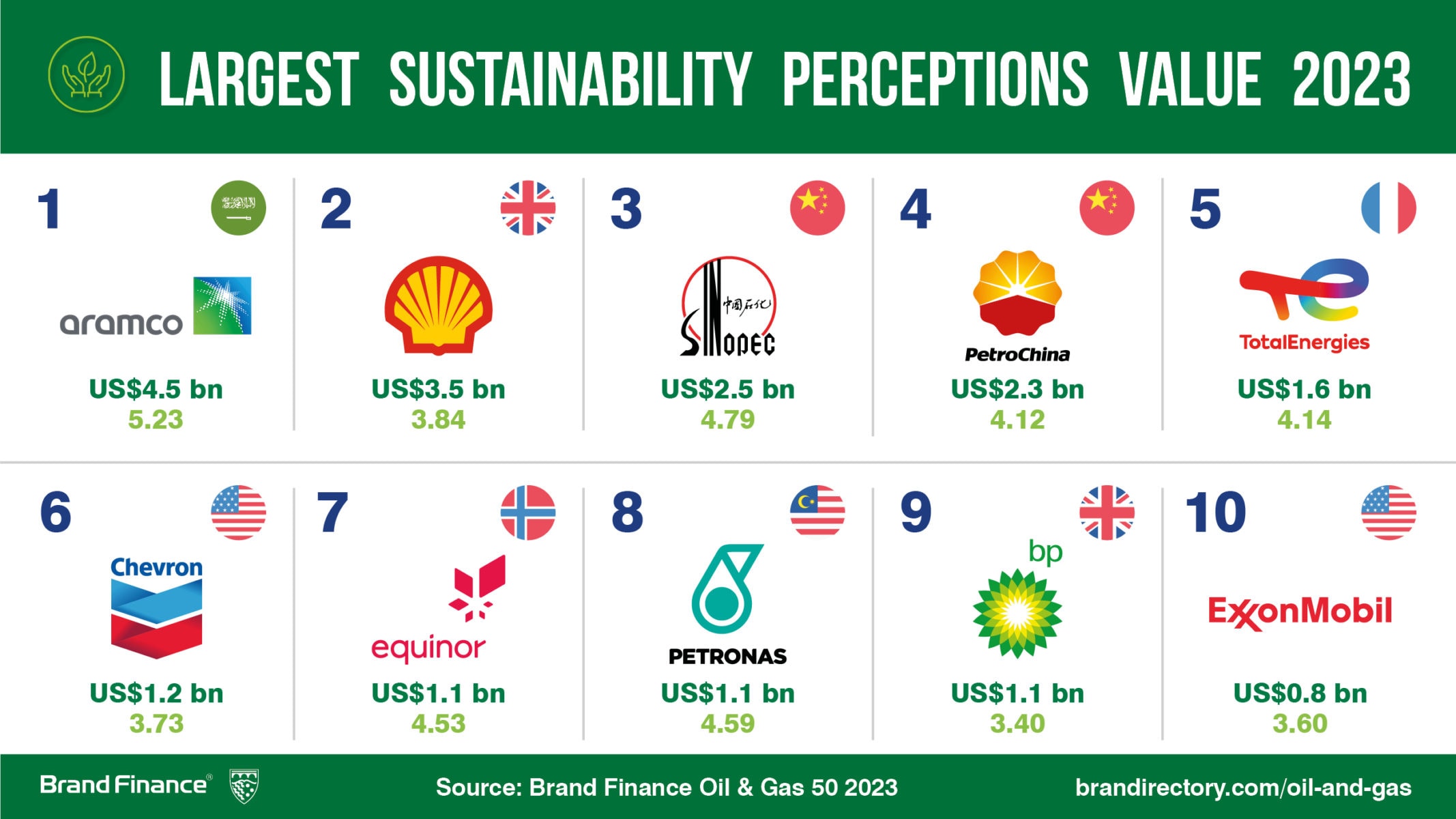View the full Brand Finance Oil & Gas 50 2023 report here
Shell remains the world’s most valuable Oil & Gas brand despite experiencing a 3% brand value reduction, taking its brand value to US$48.2 billion. This is the ninth consecutive year that the British multinational Oil & Gas brand has held the top spot, however, Saudi Arabian Oil and Gas giant, Aramco (brand value up 4% to US$45.2 billion) has reduced the gap at the top.
Every year, leading brand valuation consultancy Brand Finance puts 5,000 of the biggest brands to the test, and publishes over 100 reports, ranking brands across all sectors and countries. The world’s top 50 most valuable and strongest brands in the Oil & Gas industry are included in the annual Brand Finance Oil & Gas 50 2023 ranking.
Savio D’Souza, Valuation Director, Brand Finance, commented:
“The Oil & Gas industry had a record year in terms of profits and cash flow driven by the recovery from the pandemic and geopolitical uncertainty. Geopolitics and economic uncertainty is likely to play a big role in the year ahead too. The challenge for Oil & Gas Brands will be to optimise their brand and business positioning for the Global Energy Transition while balancing their responsibility to provide affordable energy to the world.”

In addition to calculating brand value, Brand Finance also determines the relative strength of brands through a balanced scorecard of metrics evaluating marketing investment, stakeholder equity, and business performance. Compliant with ISO 20671, Brand Finance’s assessment of stakeholder equity incorporates original market research data from over 150,000 respondents in 38 countries and across 31 sectors.
PETRONAS (brand value down 7% to US$12.7 billion) is again the strongest Oil & Gas brand, a title it has held since 2020. In 2023 its Brand Strength Index (BSI) score went up two points to 89 out of 100, earning a corresponding AAA rating. This high BSI score comes partly as a result of its commitment to the industry wide energy transition, as it looks to diversify its range of energy options and significantly improve its company-wide sustainability. PETRONAS has committed to allocating 20% of its overall capital expenditure for decarbonisation projects and cleaner energy solutions from 2023 to 2026.

Qatargas (brand value up 147% to US$3.1 billion) is the world’s fastest growing Oil & Gas brand, as well as the fastest growing brand across all sectors in the Middle East in 2023. It is one of the world’s leading gas producing brands and is owned by QatarEnergy. This year, it has seen significant growth due to the increase in global demand for its product following the embargo of Russian gas by many countries. It has also benefited from the FIFA Football World Cup which took place in Qatar, for which Qatargas was an Official Sponsor. This has increased its brand awareness outside of its home market and helped boost its BSI score 5 points to 71 out of 100, with a corresponding AA rating.

As part of its analysis, Brand Finance assesses the role that specific brand attributes play in driving overall brand value. One such attribute, growing rapidly in its significance, is sustainability. Brand Finance assesses how sustainable specific brands are perceived to be, represented by a ‘Sustainability Perceptions Score’. The value that is linked to sustainability perceptions, the ‘Sustainability Perceptions Value’, is then calculated for each brand.
Brand Finance’s research identified Aramco as having the highest Sustainability Perceptions Value of any Oil & Gas brand in the ranking - US$4.5 billion. The brand’s position at the top of the Sustainability Perceptions Value table is not an assessment of its overall sustainability performance, but rather indicates how much brand value the brand has tied up in sustainability perceptions. Aramco therefore has the most value at risk in relation to sustainability. Aramco also had a strong Sustainability Perceptions Score of 5.2 out of 10, which it is taking positive steps to protect.

ENDS
Brand Finance is the world’s leading brand valuation consultancy. Bridging the gap between marketing and finance, Brand Finance evaluates the strength of brands and quantifies their financial value to help organisations make strategic decisions.
Headquartered in London, Brand Finance operates in over 25 countries. Every year, Brand Finance conducts more than 6,000 brand valuations, supported by original market research, and publishes over 100 reports which rank brands across all sectors and countries.
Brand Finance also operates the Global Brand Equity Monitor, conducting original market research annually on 6,000 brands, surveying more than 175,000 respondents across 41 countries and 31 industry sectors. By combining perceptual data from the Global Brand Equity Monitor with data from its valuation database — the largest brand value database in the world — Brand Finance equips ambitious brand leaders with the data, analytics, and the strategic guidance they need to enhance brand and business value.
In addition to calculating brand value, Brand Finance also determines the relative strength of brands through a balanced scorecard of metrics, compliant with ISO 20671.
Brand Finance is a regulated accountancy firm and a committed leader in the standardisation of the brand valuation industry. Brand Finance was the first to be certified by independent auditors as compliant with both ISO 10668 and ISO 20671 and has received the official endorsement of the Marketing Accountability Standards Board (MASB) in the United States.
Brand is defined as a marketing-related intangible asset including, but not limited to, names, terms, signs, symbols, logos, and designs, intended to identify goods, services, or entities, creating distinctive images and associations in the minds of stakeholders, thereby generating economic benefits.
Brand strength is the efficacy of a brand’s performance on intangible measures relative to its competitors. Brand Finance evaluates brand strength in a process compliant with ISO 20671, looking at Marketing Investment, Stakeholder Equity, and the impact of those on Business Performance. The data used is derived from Brand Finance’s proprietary market research programme and from publicly available sources.
Each brand is assigned a Brand Strength Index (BSI) score out of 100, which feeds into the brand value calculation. Based on the score, each brand is assigned a corresponding Brand Rating up to AAA+ in a format similar to a credit rating.
Brand Finance calculates the values of brands in its rankings using the Royalty Relief approach – a brand valuation method compliant with the industry standards set in ISO 10668. It involves estimating the likely future revenues that are attributable to a brand by calculating a royalty rate that would be charged for its use, to arrive at a ‘brand value’ understood as a net economic benefit that a brand owner would achieve by licensing the brand in the open market.
The steps in this process are as follows:
1 Calculate brand strength using a balanced scorecard of metrics assessing Marketing Investment, Stakeholder Equity, and Business Performance. Brand strength is expressed as a Brand Strength Index (BSI) score on a scale of 0 to 100.
2 Determine royalty range for each industry, reflecting the importance of brand to purchasing decisions. In luxury, the maximum percentage is high, while in extractive industry, where goods are often commoditised, it is lower. This is done by reviewing comparable licensing agreements sourced from Brand Finance’s extensive database.
3 Calculate royalty rate. The BSI score is applied to the royalty range to arrive at a royalty rate. For example, if the royalty range in a sector is 0-5% and a brand has a BSI score of 80 out of 100, then an appropriate royalty rate for the use of this brand in the given sector will be 4%.
4 Determine brand-specific revenues by estimating a proportion of parent company revenues attributable to a brand.
5 Determine forecast revenues using a function of historic revenues, equity analyst forecasts, and economic growth rates.
6 Apply the royalty rate to the forecast revenues to derive brand revenues.
7 Discount post-tax brand revenues to a net present value which equals the brand value.
Brand Finance has produced this study with an independent and unbiased analysis. The values derived and opinions presented in this study are based on publicly available information and certain assumptions that Brand Finance used where such data was deficient or unclear. Brand Finance accepts no responsibility and will not be liable in the event that the publicly available information relied upon is subsequently found to be inaccurate. The opinions and financial analysis expressed in the study are not to be construed as providing investment or business advice. Brand Finance does not intend the study to be relied upon for any reason and excludes all liability to any body, government, or organisation.
The data presented in this study form part of Brand Finance's proprietary database, are provided for the benefit of the media, and are not to be used in part or in full for any commercial or technical purpose without written permission from Brand Finance.